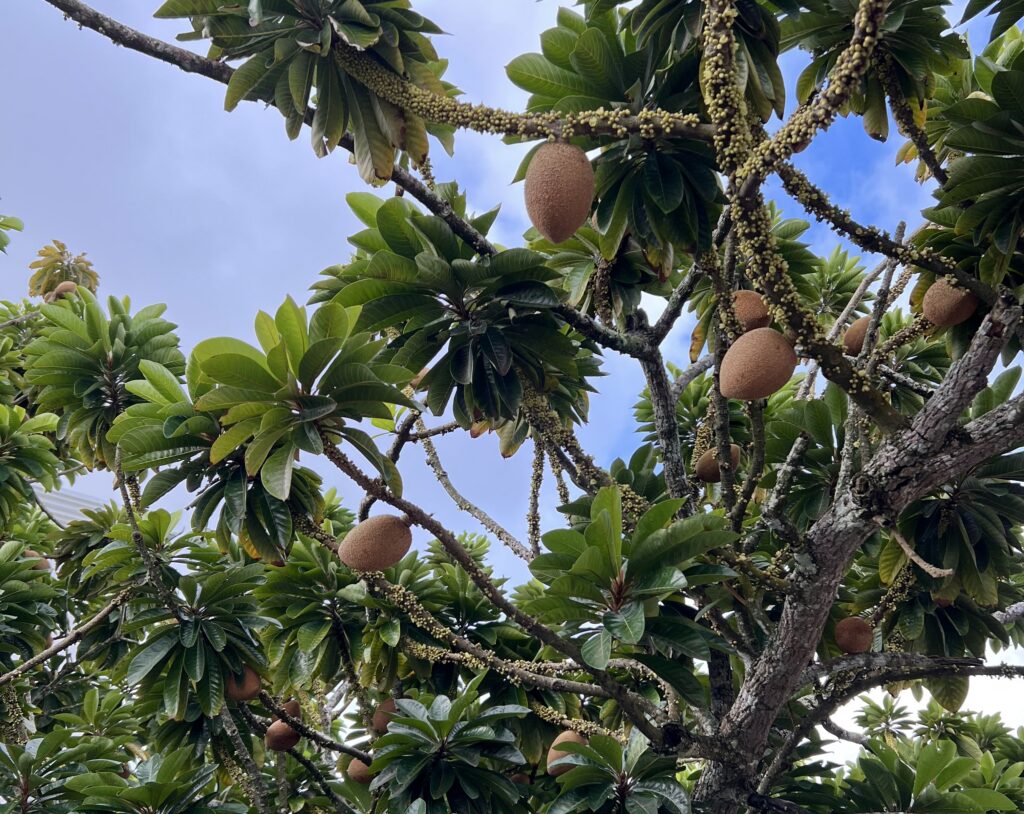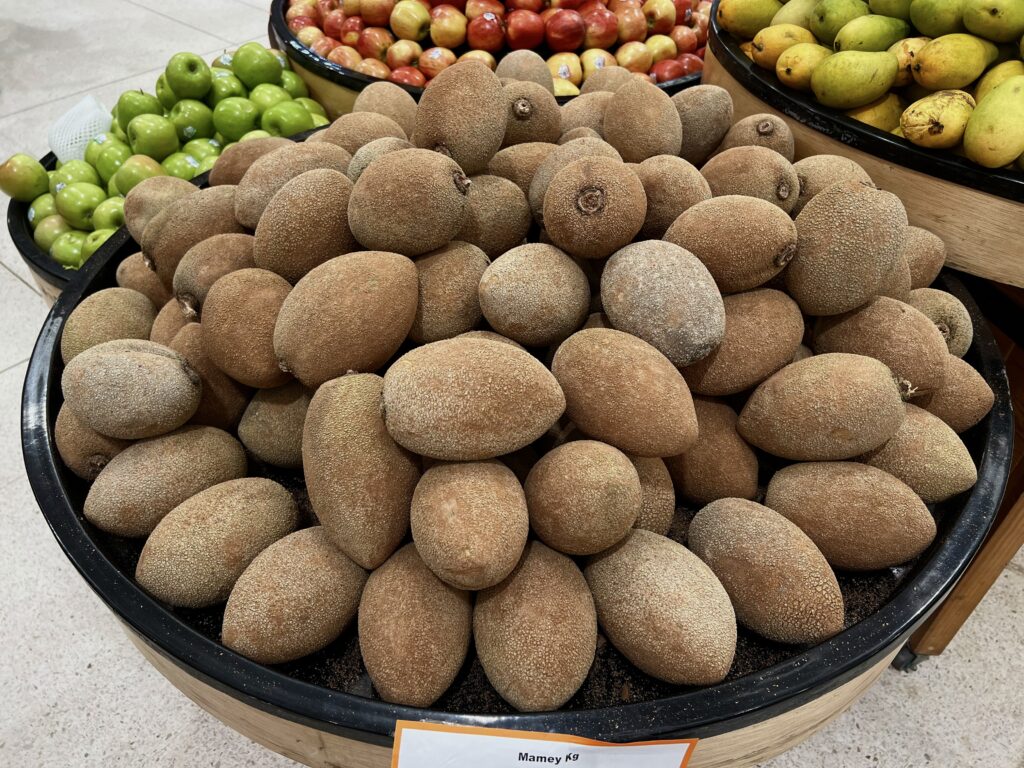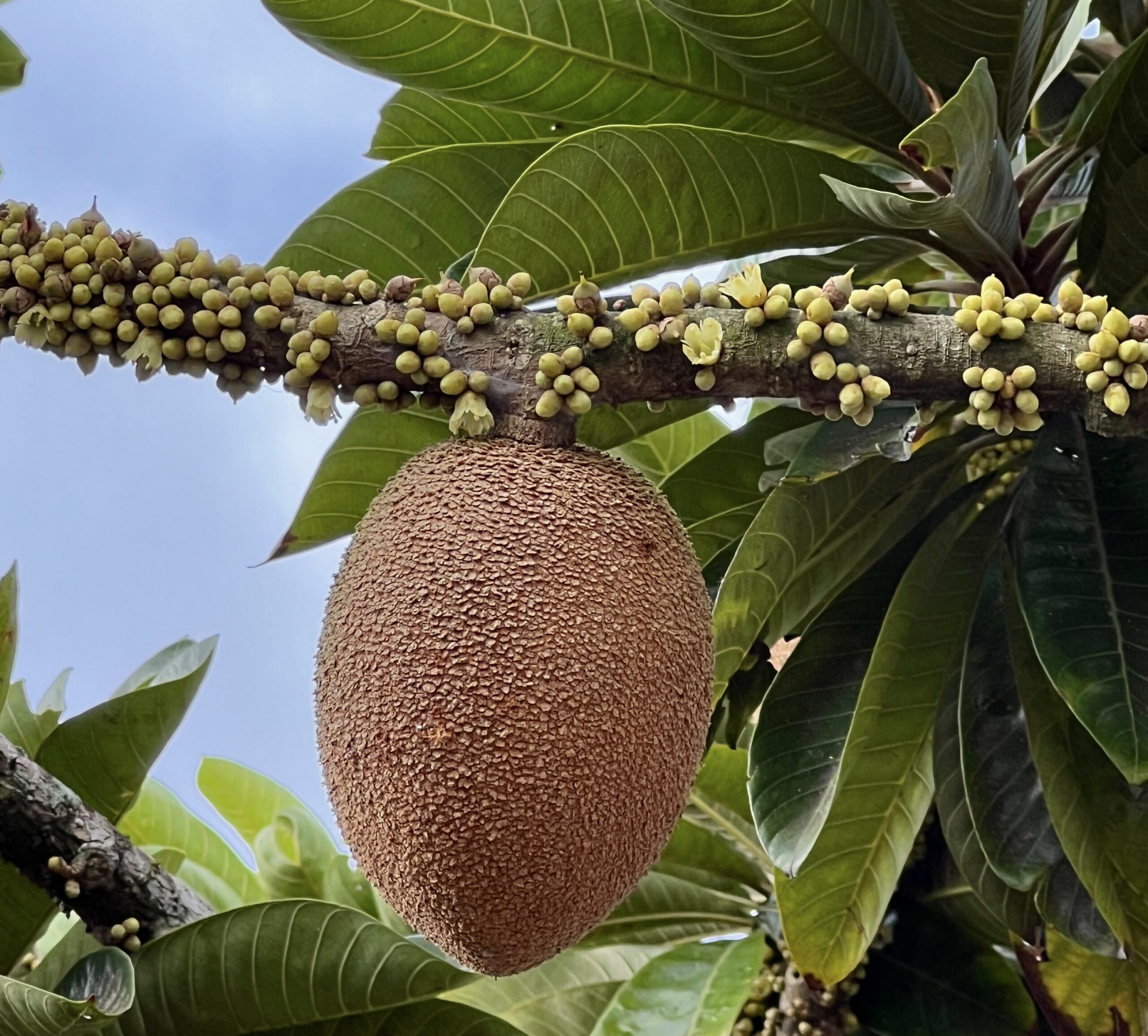
So, you’re planning a vacation in Cancun, the Riviera Maya, or another Caribbean destination? Do you enjoy trying new exotic fruits? If so, you’re in luck, because this region offers a bounty of unique fruits and vegetables. In addition to local varieties of avocado, there’s another exotic fruit you should add to your must-try list: mamey. When in season, you’ll find mamey readily available throughout Cancun, both in major chains like Chedraui and Walmart, as well as in local markets. Just be sure you know what to look for!
What is Mamey Fruit?
Botanically, mamey sapote (often just called “mamey”) is the fruit of Pouteria sapota, a tropical tree belonging to the Sapotaceae family. This family includes several other tropical fruit-bearing plants known for their sweet, creamy fruits. In its native regions, mamey sapote grows on large, evergreen trees that thrive in warm climates, producing oval-shaped fruits with a distinctive brown, slightly rough skin.
It may not look very appealing on the outside. It can appear a bit scruffy, but once you open it up, you’ll find a vibrant, creamy flesh that ranges from pink to orange or red. When you cut into a ripe mamey, you’ll notice a sweet aroma and a flavor that many people compare to a mix of sweet potato, pumpkin, honey, and apricot.
Keep in mind that “mamey” can refer to different fruits in various regions. Mammea americana, also called mammee apple or mamey apple, is a distinct species despite sharing a similar name. Its taste, appearance, and botanical classification differ from mamey sapote, so don’t be surprised if you come across two very different fruits that happen to share the same name!

Where Does Mamey Sapote Come From?
Mamey sapote has deep roots in Mesoamerica, where it grew wild long before European contact. Early indigenous civilizations, such as the Maya, are believed to have cultivated and consumed the fruit for both its nutritional value and its sweet flavor. Spanish chroniclers and explorers in the 16th century took note of many tropical fruits they encountered in the New World, including varieties of sapote, which they described in letters and reports back to Europe. Over time, the fruit spread throughout Mexico and Central America, gradually gaining recognition in other tropical regions. Today, mamey sapote stands as both a traditional staple in its native homelands and a sought-after delicacy in international markets.
Where Does the Word Mamey Come From?
The word mamey comes from the Taíno language, once spoken by the indigenous Taíno people of the Caribbean, particularly in the Greater Antilles (including Cuba, Jamaica, Hispaniola, and Puerto Rico) and parts of the Bahamas. In Taíno, “mamey” referred to the fruit of Mammea americana, also called the mammee apple. Spanish speakers adopted this word as “mamey,” and English later borrowed it with the same spelling.
Over time, people began using “mamey” for other fruits in different regions. Notably, Pouteria sapota—known as mamey sapote—thrives in Mexico and Central America. This fruit likely took on the name “mamey” because it shares certain similarities in appearance and taste with the original mammee apple.
Thus, while “mamey” originally described Mammea americana, it now applies to other fruits like Pouteria sapota as well.
Health Benefits
Mamey sapote packs a big health punch in every bite and makes an excellent addition to a balanced diet. Its dietary fiber supports smooth digestion and promotes regularity, helping you feel lighter throughout the day. Vitamins C and E work together to combat oxidative stress, potentially lowering your risk of chronic diseases. The fruit’s healthy dose of potassium teams up with fiber to keep your heart strong and support healthy blood pressure levels. You’ll also find iron in this tropical delight, which assists in red blood cell production and wards off anemia. With its immune-boosting vitamin C, mamey sapote can be a delicious way to help your body fight colds and infections year-round.

How to Enjoy Mamey?
Mamey sapote offers endless possibilities in the kitchen thanks to its sweet, creamy flesh and versatile flavor profile. One of the simplest ways to enjoy it is fresh—simply slice open a ripe mamey. Then you remove its central seed, and scoop out the pulp with a spoon. If you’re craving something indulgent, blend the fruit with milk (dairy or plant-based) and a sweetener for smoothies and refreshing milkshakes. Its natural richness also works beautifully in desserts like flan, cheesecakes, and ice creams, adding moisture and flavor. For a savory twist, try incorporating mamey sapote into glazes or sauces, and don’t forget about jams and preserves!
Our favorite way to enjoy mamey sapote is as a cold dessert after lunch or dinner. We usually refrigerate a couple of ripe fruits and cut them open right before eating. The flesh of a ripe mamey sapote is soft and moist, with a texture similar to a baked sweet potato or even a firm scoop of ice cream. Its flavor is rich and sweet.
When Is Mamey Fruit in Season?
Mamey sapote typically ripens from late winter through early summer, bringing a sweet and colorful taste of the tropics. In Mexico, the harvest varies by region. The Yucatan Peninsula enjoys a fruitful season from January through July. The mature trees here can produce up to half a ton of fruit. Central Mexico (especially Chiapas) sees fresh mamey around February. Although some markets carry mamey year-round, the best selection appears between January and March. If you find yourself in Cancun or the Riviera Maya, plan your visit between January and July to savor the freshest, most delicious mamey sapote.
How to Choose Mamey Fruit?
Selecting a ripe mamey sapote is key to experiencing its rich flavor and creamy texture. Look for a brownish-red skin; green tones usually indicate the fruit isn’t ready. A gentle press should reveal a slight give, similar to a ripe avocado. If the flesh is too firm it means more ripening time is needed. Another handy trick is the scratch test: lightly scrape the skin near the stem and check for vibrant orange or reddish flesh. If it’s greenish, the fruit isn’t ripe yet. A subtle, sweet aroma is another good sign that your mamey sapote is ready to enjoy. By considering these factors, you’ll ensure a delightful taste experience every time.

What Else Can Mamey Fruit Do Beyond the Kitchen?
Now that we’ve explored mamey fruit’s unique flavors and nutritional benefits, let’s look beyond its culinary appeal. You might be surprised to learn that mamey sapote also plays an important role in the beauty industry, especially in hair and skin care products.
If you’re looking for a natural, multi-purpose oil that can transform both your hair and skin, mamey sapote oil might be your new go-to. It is extracted from the seeds of the mamey sapote fruit. And this nourishing oil is packed with vitamins A, B, C, and E, along with essential fatty acids. That nutrient-rich profile makes it a powerhouse for beauty applications.
On the hair front, mamey sapote oil provides deep nourishment to your scalp and helps balance sebum production. This can benefit both oily and dry hair types. Its anti-inflammatory properties may reduce dandruff or eczema, while regular use strengthens hair strands and minimizes breakage. If you have curly hair, you’ll love how it seals the cuticle, prevents moisture loss, and tames frizz to define those curls.
For skin care, mamey sapote oil’s emollient properties deliver intense hydration, leaving your skin soft and supple. Its high antioxidant content can also help combat signs of aging like fine lines and wrinkles. Plus, the vitamin C in this oil promotes brighter skin and a more even tone.
You’ll find mamey sapote oil in many cosmetic products, including soaps, creams, and conditioners, all thanks to its incredible ability to nourish and moisturize.
Conclusion
Mamey sapote truly stands out as a versatile, nutrient-packed fruit with a long history in Mesoamerica. It was treasured there for both taste and health benefits. Its sweet, creamy flesh works beautifully in dishes ranging from fresh snacks to indulgent desserts. Its extended growing season ensures that you can enjoy its tropical goodness year-round. Whether you slice it open to savor its flavor or blend it into smoothies, mamey sapote delivers nutrients like fiber, potassium, vitamins C and E, and iron. Beyond the kitchen, its seed oil supports hair and skin care, making mamey sapote a unique, all-around wellness treasure.
Want to explore more of the incredibly tasty treasures Mexico has to offer? You definitely won’t want to miss our article about The Mexican Avocado!




